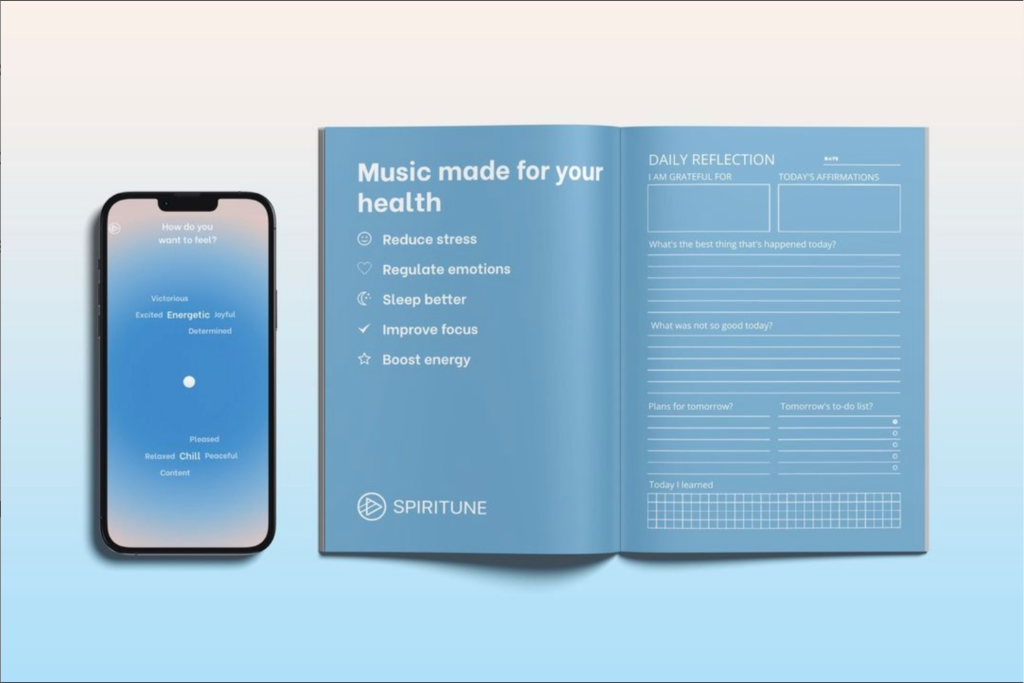Music used in the mental health field has been an established practice, with proven results in improving cognitive and emotional states. With its unique blend of science and music, Spiritune is quickly becoming the go-to choice for those seeking a customized approach to mental health. With research-backed principles and a commitment to improving mental health, one sound at a time, this app is a game-changer in the world of mental health technology.
How Spiritune Works
Spiritune prioritizes science and clinical underpinnings in its therapeutic application of music. Their origins stem from a research project aimed at combining music therapy and science to create a more reliable effect. Although people intuitively understand the emotional power of music, it does not always provide a concrete answer. Simply listening to music at random can potentially make us feel better, but the app seeks to provide a more consistent, personalized, and reliable therapeutic effect.
“I was curious about a more reliable approach to using music to help with emotions,” Jamie Pabst, founder of Spiritune, explains. “My knowledge of music therapy, inspired by my sister who pursued a degree in the field, led me to investigate using music in a clinical setting to help people with various mental health needs or neurological disorders. That’s how Spiritune was born, as a way to create personalized playlists using music therapy and neuroscience principles for a reliable and effective approach to improving mental health.”
Jamie collaborated with leading music therapists and neuroscientists to develop a deeper understanding of how specific music features can target various emotional and cognitive states. Through this research, they identified the top musical elements that can have a physiological impact on stress, anxiety, or other specific emotional states. By analyzing the emotional needs that people commonly have, ranging from negative states like anxiety, fatigue, loneliness, and depression to positive states like peacefulness, energy, and determination, Jamie and their team integrated this knowledge into the app’s personalized playlists. These playlists now provide an effective and reliable method to improve mental health.
“We started by giving a framework to musical features that are pegged to emotional states, which resulted in 40 sonic recipes,” Jamie says. “Similar to baking, we then had composers and artists create music based on these recipes. Our initial research project informed the design and personalization of the app, as we drew from the principles of music therapy and neuroscience to create and publish the music in the app. One of the principles we used was the ISO principle, which states that to shift someone’s mood, you have to start in their original emotional state. This principle is a cornerstone of the app’s design, allowing users to start where they are and move to where they want to go.”
Spiritune’s user design and experience prioritize simplicity, given the difficulties of modern life. When users open the app, it immediately prompts them to select their current emotional state from a range of options, such as lethargic, anxiety, chill, or energized. From there, they choose their desired emotional state, with the app automatically removing any negative options in order to set up a trajectory toward a more positive target state. Finally, users can select the activity they are engaged in, such as waking up or addressing brain fog. This thoughtful design approach ensures user-friendliness and provides a personalized experience for the user.
“We have four categories in the app: Waking Up, Workflow, Winding Down, and Sleep. Workflow is designed to address a variety of emotions and optimize focused attention, Waking Up is designed for brain fog and morning lethargy, while Winding Down is meant for deep relaxation,” Jamie says. “Lastly, our Sleep category is intended to help users fall asleep faster and improve sleep quality. We pull a track from our music library that specifically corresponds to the user’s input of their current emotional state, desired emotional state, and current activity. The track is designed to transition the user from their initial state to their desired state. Our goal is to provide a simple user experience, with the design intentionally kept straightforward, as we understand that people have enough complexity in their lives.”
The Impact of Spiritune
Spiritune has reported a high success rate among its users. The app features an in-app survey that appears every ten minutes during a listening session. This survey allows users to provide feedback on whether they are achieving their desired emotional state. To date, the survey has collected over 4,500 responses, which continues to grow. Users have the option to respond with ‘Yes’, ‘No’, and ‘Somewhat’, and according to the data, 92 percent of users report reaching their desired emotional state.
“In addition to the in-app survey, we collect user testimonials and occasionally conduct more in-depth surveys by email,” Jamie says. “However, the in-app survey provides a good starting point because of the many touchpoints and responses we receive daily, which is very encouraging!”
As Spiritune has received praise as a powerful tool for improving mental health, the team behind the app initially sought to understand the emotional states or mental health issues that people typically experience throughout the day. According to user feedback, in some instances, Spiritune has been effective in helping people fall asleep without the need for anxiety medication. In contrast, some users have reported greater benefits than talking to a therapist. Users listen to the workflow category approximately 45 percent of the time on the app and report improved focus, energy, and mental clarity.
“Our initial work revealed a broad range of emotions that could be addressed by adapting musical features,” Jamie says. “These emotions included both subclinical issues such as everyday stress and fatigue and more clinical issues such as anxiety or depression. We found it encouraging that our mission could assist people with various emotions throughout their day since most individuals experience a range of emotions every day. That go us to start asking ourselves what mental health emotions music could meaningfully address, which included a range of subclinical everyday stress to clinical anxiety and depression. We didn’t want to limit ourselves to addressing just one emotion, so we developed 40 distinct sonic briefs that could address a broad range of emotions as well as activities throughout the day.”
Ensuring accessibility is crucial for the effectiveness of mental health tools. The issue of accessibility is particularly pressing on mental health, where long wait times for therapy and a shortage of therapists can be significant barriers for many individuals seeking help. People suffering from anxiety and other emotional challenges may experience a lack of relief when therapy is inaccessible. This is why Spiritune places such a high priority on accessibility, recognizing that music can be just as effective as traditional talk therapy.
“The cost of digital devices has decreased while the quality has increased, making them more accessible to people worldwide,” Jamie explains. “We have tested different pricing strategies for Spiritune, and we believe that our average monthly cost is affordable, especially when compared to the overall cost of mental health services. Compared to other mental health solutions, our cost is already very low. Additionally, we serve specific underserved or in-need populations, such as military health, and provide the app for free in some cases because we feel a responsibility to address high levels of stress and anxiety as well as their need for high performance in these individuals. Therefore, we offer Spiritune for free to certain populations.”
Comparison With Traditional Methods
As mental health continues to be a critical issue around the world, people are turning to various methods to address the problem. Music therapy has emerged as a powerful tool, in addition to widely used traditional methods such as talk therapy and medication. First introduced in the late 1700s, music therapy is a standalone treatment that has been found to be effective in connection with other types of care, including talk therapy. Studies show that incorporating music therapy can significantly improve health outcomes, making it a promising option for those seeking to improve their mental health.
“When seeing a therapist once a week for an hour, there are many days and hours in between sessions where symptoms can still persist,” Jamie says. “Music therapy can be applied in between sessions to help alleviate symptoms on a daily basis, resulting in greater benefits than just seeing a therapist once a week. By combining music therapy with talk therapy, greater health outcomes can be achieved. In terms of differences between music therapy and talk therapy, the latter relies on the cognitive side of the brain to make sense of emotions, which can sometimes be at odds with each other.”
Mental health professionals use talk therapy to help individuals articulate and understand their emotions. However, this approach assumes that individuals have a correct understanding of their feelings, which is not always the case. In contrast, music therapy offers a unique benefit in that it can bypass the cognitive side of the brain and directly affect the brain networks involving emotions. By doing so, music therapy can be a valuable tool in helping individuals improve their mental health.
“As we listen to music, it speaks to our emotions, creating ease within ourselves,” Jamie says. “This release can also help us open up and allow the cognitive side of our brain to speak our emotions. Thus, music therapy differentiates itself from talk therapy in certain ways, but can also complement it in a wonderful way.”
People across various cultures and time periods have used music as a tool for self-regulation for centuries. However, mental health professionals have not paid much attention to it as a reliable response to mental health issues. It is crucial to acknowledge that music can be a valuable component of mental health routines, and education on this matter is vital. Spiritune recognizes the therapeutic potential of music and has made it its mission to integrate it into its platform. By simply pressing a few buttons, individuals can have Spiritune playing in the background while they go about their day, making it an easily accessible therapeutic tool.
Spiritune is available now on iOS or Android.











